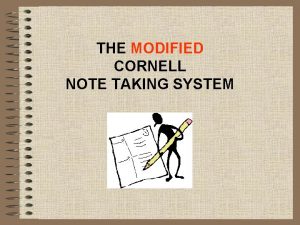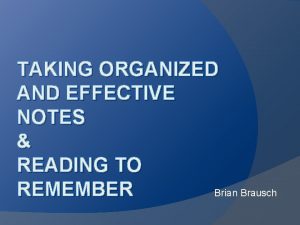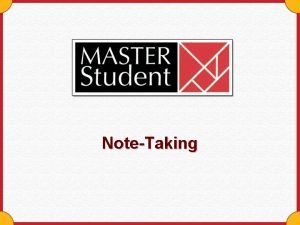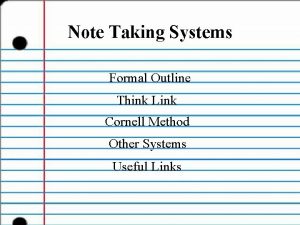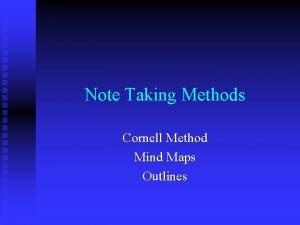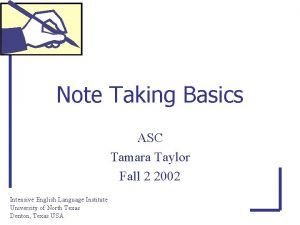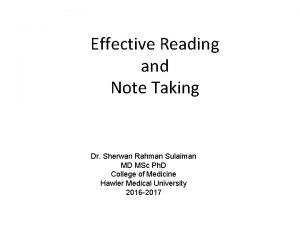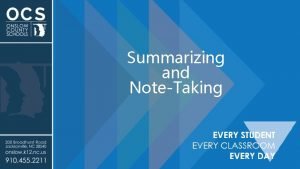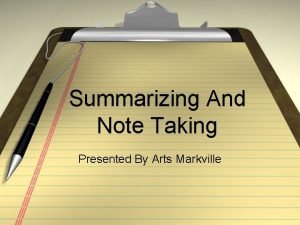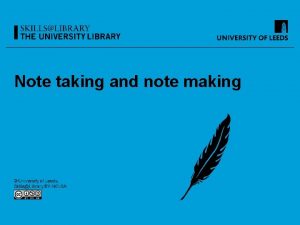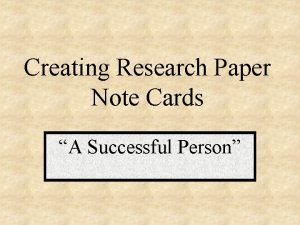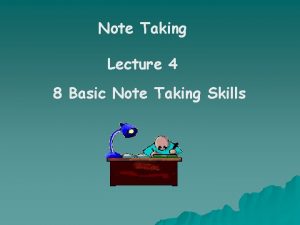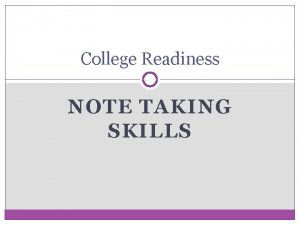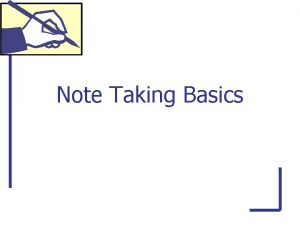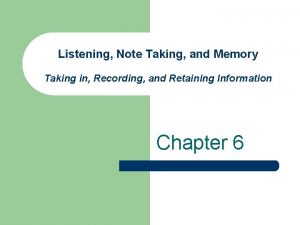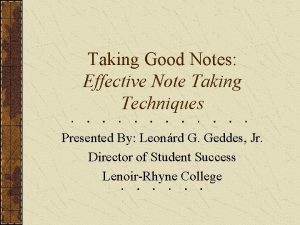Note Taking Note Taking l Where are you





























- Slides: 29

Note Taking

Note Taking l Where are you going? Outlining l How do I get there? l What are the dangers? Plagiarism Note taking

INTRODUCTION (5%) Introduce the passage l Include a thesis statement—a sentence covering that main idea of the text. l Use strategies from Comp. 1 l

BACKGROUND (15%) Date l Author l Recipients l Genre l Outline l Historical setting l Location of book l

CONTENT (50%) The overall perspective of the chapter. l The specific explanations of the verses. l They may be discussed one at a time or you may group them together. A number of significant word studies. l

APPLICATION (25%) How do specific passages apply to your life? l Use real life examples from other sources. l Use personal examples. l Create examples. l

CONCLUSION (5%) Wrap up the passage l What final thoughts do you have to say about the passage? l Tie the conclusion into the introduction. l Use strategies from Comp. 1. l

Take Your Notes Overview Notes l Summary Notes l Paraphrase Notes l Quotation Notes l Comment Notes l

Overview Notes l Thesis of the Source l Write the main idea of the article or chapter in one to two sentences. l Outline of the Source l Write a sentence or phrase outline of the main points of the source. Use quotes if you use exact wording.

Hate or Hyperbole

Summary Notes Use the author’s ideas Use your own words and sentence structure Use the author’s name and page number(s) Use for uncommon knowledge Use 1 -3 sentences Use these when you want to present a large amount of information in a concise format. Use these when you want to simplify a complex idea Use these when you want to present background information.

Paraphrase Notes l l l l Use the author’s ideas. Use your own words and sentence structure. Use the author’s name and page number(s). Use uncommon knowledge. Use about the same length of words as the source. Use when you want to present specific and detailed information. Use when you want to present a list, series, or steps of information.

Quotation Notes l l l l l Use the author’s ideas. Use the author’s exact words and sentence structure. Use quotation marks around the exact wording. Use uncommon knowledge. Use the author’s name and page number(s). Use present tense verbs as a lead-in to the quote. Use when you want to emphasis not only the idea but the exact wording. Use when you want to focus on a specific idea without misrepresenting the original source. Use when you want to include a “bumper sticker” idea in the paper. Use for 10 -20% of your total sources in a paper.

Comment Notes Use your ideas and your words and sentence structure. l Use for common knowledge. l Use to reflect your personal perspective or beliefs. l Use to reflect on the summaries, paraphrases, or quotations. l Use a variety of lengths. l

Format of Notes

Smith, James R. Protection Page 57 Summary The shepherding model of leadership captures the profound practice of the Lord in leading his church. In particular, the Lord disciplines his people and protects his people from evil as the shepherd uses a rod and a staff.

Purpose of Prayer Smith 457 Summary Prayer is a gift to believers as a means to communicate with their Father. It is to be used not only to bring petitions to God but to express praise and thankfulness to him. Examples of Prayer Jones 45 Paraphrase There are three examples of Jesus praying during a crises. 1. He prayed in the wilderness at the beginning of his ministry 2. He prayed on the mountain all night before selecting the 12 apostles. 3. He prayed in the garden only hours before he was arrested.

Plagiarism

Plagiarism l Buy a paper from a commercial paper mill (lazystudents. com).

Plagiarism l Download a free paper from the Internet (freeesay. com).

Plagiarism l Copy an article, in part or in whole, from the Internet.

Plagiarism l Translate a foreign Web article into English (http: //babelfish. altavista. com).

Plagiarism l Borrow a paper, in part or in whole, from another individual.

Plagiarism l Cut and paste from several sources to create a paper.

Plagiarism l Falsify a citation.

Plagiarism l Fail to place quotation marks around all copied words, phrases, or four sentences or less with or without a citation. (Or fail to indent more than four copied sentences, with or without a citation).

Plagiarism l Change only a few words within a copied section without quotation marks or indentation, with or without a citation.

Plagiarized Summary The psalm shows our confidence in God’s goodness—now and later (Van. Gemenen 214).

Plagiarism l Paraphrase or summarize without a citation.
 Antigentest åre
Antigentest åre Listening
Listening Difference between note making and note taking
Difference between note making and note taking Signal words for cause and effect
Signal words for cause and effect Difference between note making and note taking
Difference between note making and note taking Relevance of note making
Relevance of note making Note taking legend
Note taking legend Outline method of note taking
Outline method of note taking Section 17-3 practice commonly abused drugs
Section 17-3 practice commonly abused drugs What are the 5 r's of note taking
What are the 5 r's of note taking What are the 5 r's of note taking
What are the 5 r's of note taking Note taking process
Note taking process Formal note taking
Formal note taking Prerequisites of note-taking
Prerequisites of note-taking Mind mapping note taking method
Mind mapping note taking method Tyutyuy
Tyutyuy Cornell note taking method
Cornell note taking method Phase 3 of focused note taking
Phase 3 of focused note taking Note taking abbreviations
Note taking abbreviations Cornell note taking strategy
Cornell note taking strategy Cornell note taking strategy
Cornell note taking strategy Sentence method of note taking
Sentence method of note taking Summarizing and note taking strategies
Summarizing and note taking strategies Summarizing and note taking strategies
Summarizing and note taking strategies Objectives of note taking
Objectives of note taking Note taking worksheet answers
Note taking worksheet answers How to write note making
How to write note making Research paper notecards
Research paper notecards Focused note taking
Focused note taking Tnetn
Tnetn






